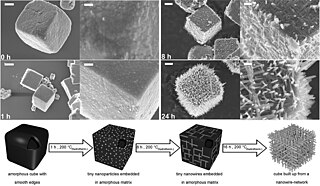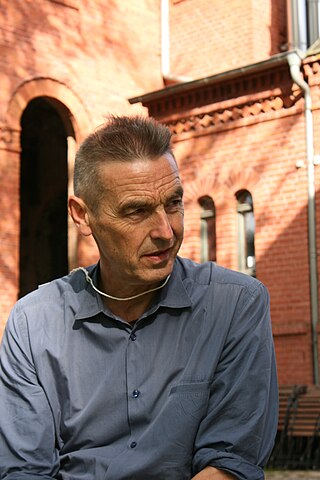Strategy is a general plan to achieve one or more long-term or overall goals under conditions of uncertainty. In the sense of the "art of the general", which included several subsets of skills including military tactics, siegecraft, logistics etc., the term came into use in the 6th century C.E. in Eastern Roman terminology, and was translated into Western vernacular languages only in the 18th century. From then until the 20th century, the word "strategy" came to denote "a comprehensive way to try to pursue political ends, including the threat or actual use of force, in a dialectic of wills" in a military conflict, in which both adversaries interact.

Bottom–up and top–down are both strategies of information processing and ordering knowledge, used in a variety of fields including software, humanistic and scientific theories, and management and organization. In practice they can be seen as a style of thinking, teaching, or leadership.
The Abilene paradox is a collective fallacy, in which a group of people collectively decide on a course of action that is counter to the preferences of most or all individuals in the group, while each individual believes it to be aligned with the preferences of most of the others. It involves a breakdown of group communication in which each member mistakenly believes that their own preferences are countered to the group's, and therefore does not raise objections, or even states support for an outcome they do not want.
Organization development (OD) is the study and implementation of practices, systems, and techniques that affect organizational change. The goal of which is to modify a group's/organization's performance and/or culture. The organizational changes are typically initiated by the group's stakeholders. OD emerged from human relations studies in the 1930s, during which psychologists realized that organizational structures and processes influence worker behavior and motivation.

Peter Michael Senge is an American systems scientist who is a senior lecturer at the MIT Sloan School of Management, co-faculty at the New England Complex Systems Institute, and the founder of the Society for Organizational Learning. He is known as the author of the book The Fifth Discipline: The Art and Practice of the Learning Organization.

Self-organization, also called spontaneous order in the social sciences, is a process where some form of overall order arises from local interactions between parts of an initially disordered system. The process can be spontaneous when sufficient energy is available, not needing control by any external agent. It is often triggered by seemingly random fluctuations, amplified by positive feedback. The resulting organization is wholly decentralized, distributed over all the components of the system. As such, the organization is typically robust and able to survive or self-repair substantial perturbation. Chaos theory discusses self-organization in terms of islands of predictability in a sea of chaotic unpredictability.
Theories of technological change and innovation attempt to explain the factors that shape technological innovation as well as the impact of technology on society and culture. Some of the most contemporary theories of technological change reject two of the previous views: the linear model of technological innovation and other, the technological determinism. To challenge the linear model, some of today's theories of technological change and innovation point to the history of technology, where they find evidence that technological innovation often gives rise to new scientific fields, and emphasizes the important role that social networks and cultural values play in creating and shaping technological artifacts. To challenge the so-called "technological determinism", today's theories of technological change emphasize the scope of the need of technical choice, which they find to be greater than most laypeople can realize; as scientists in philosophy of science, and further science and technology often like to say about this "It could have been different." For this reason, theorists who take these positions often argue that a greater public involvement in technological decision-making is desired.
A learning cycle is a concept of how people learn from experience. A learning cycle will have a number of stages or phases, the last of which can be followed by the first.
The viable system model (VSM) is a model of the organizational structure of any autonomous system capable of producing itself. It is an implementation of viable system theory. At the biological level, this model is correspondent to autopoiesis.
Reflective practice is the ability to reflect on one's actions so as to take a critical stance or attitude towards one's own practice and that of one's peers, engaging in a process of continuous adaptation and learning. According to one definition it involves "paying critical attention to the practical values and theories which inform everyday actions, by examining practice reflectively and reflexively. This leads to developmental insight". A key rationale for reflective practice is that experience alone does not necessarily lead to learning; deliberate reflection on experience is essential.
Robert Kegan is an American developmental psychologist. He is a licensed psychologist and practicing therapist, lectures to professional and lay audiences, and consults in the area of professional development and organization development.

Bernardus Cornelis Johannes Lievegoed was a Dutch medical doctor, psychiatrist and author. He is most famous for establishing a theory of organizational development. He founded the N.P.I., or Netherlands Pedagogical Institute, which works with organizations and individuals to help these realize their economic, social and cultural goals. He also founded the Vrije Hogeschool in Driebergen.

The sociology of human consciousness or the sociology of consciousness uses the theories and methodology of sociology to explore and examine consciousness.

Management cybernetics is concerned with the application of cybernetics to management and organizations. "Management cybernetics" was first introduced by Stafford Beer in the late 1950s and introduces the various mechanisms of self-regulation applied by and to organizational settings, as seen through a cybernetics perspective. Beer developed the theory through a combination of practical applications and a series of influential books. The practical applications involved steel production, publishing and operations research in a large variety of different industries. Some consider that the full flowering of management cybernetics is represented in Beer's books. However, learning continues.

Connectionist Learning with Adaptive Rule Induction On-line (CLARION) is a computational cognitive architecture that has been used to simulate many domains and tasks in cognitive psychology and social psychology, as well as implementing intelligent systems in artificial intelligence applications. An important feature of CLARION is the distinction between implicit and explicit processes and focusing on capturing the interaction between these two types of processes. The system was created by the research group led by Ron Sun.

Otto Scharmer is a senior lecturer at the Massachusetts Institute of Technology (MIT) and co-founder of the Presencing Institute and its u-school for Transformation. He focuses on awareness-based action research with leaders across various sectors, anchored in the concept of presencing, a method of "learning from the emerging future", which he introduced in his books Theory U (2007) and Presence.
A social-ecological system consists of 'a bio-geo-physical' unit and its associated social actors and institutions. Social-ecological systems are complex and adaptive and delimited by spatial or functional boundaries surrounding particular ecosystems and their context problems.
The viable systems approach (VSA) is a systems theory in which the observed entities and their environment are interpreted through a systemic viewpoint, starting with the analysis of fundamental elements and finally considering more complex related systems. The assumption is that each entity/system is related to other systems, placed at higher level of observation, called supra-systems, whose traits can be detected in their own subsystems.

Raymond-Alain Thietart is a French business school professor. He is the author of eight books on strategy and management and over a hundred articles in the same field. His research and teaching focus on organization theory and strategic management.
Autonomous agency theory (AAT) is a viable system theory (VST) which models autonomous social complex adaptive systems. It can be used to model the relationship between an agency and its environment(s), and these may include other interactive agencies. The nature of that interaction is determined by both the agency's external and internal attributes and constraints. Internal attributes may include immanent dynamic "self" processes that drive agency change.










